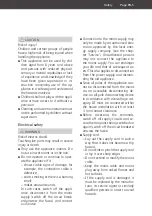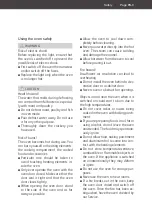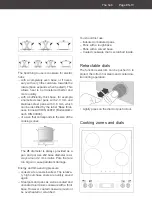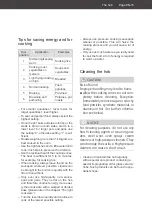
Page EN-12
The hob
Requirements
– You have read the chapter “Safety notices”
at the beginning of this manual.
– The appliance is connected, as described
in chapter “Fitting and installation“ from
page EN-29.
– You have thoroughly cleaned the oven
(see “Cleaning before use” on page EN-33).
Glass ceramic hob
Unlike cast-iron hobs, your cooker has a flat
hob made from glass ceramic with clearly vis-
ible cooking zones. So that the glass ceramic
does not become damaged and lasts for a
long time, you need to care for it and maintain
it and use suitable cookware.
WARNING
Risk of electric shock!
Touching live parts may result in severe
injury or death.
■
Do not continue to cook if you fi nd
cracks in the glass ceramic. Water that
runs through cracks inside the device
may be live! If there are cracks in the
glass ceramic, disconnect the glass
ceramic hob from the mains supply
(switch off circuit breaker(s)/unscrew
fuse[s]) and then contact our Service
(see page EN-35).
Fire hazard!
■
When you are cooking with fats or
oils, leaving your food unattended on
the hob can be dangerous and may
result in a fi re.
The hob
CAUTION
Risk of injury!
Metallic objects such as knives, forks,
spoons and lids should not be placed on
the hob surface since they can get hot.
NOTICE
Risk of damage!
Improper handling of the appliance
may result in damage.
■
Do not push heavy pans across the
appliance; The glass ceramic may be-
come scratched.
■
Wipe the hob and the base of the
pots prior to use to wipe away any
dirt which may cause scratches.
■
Use the hob as a work surface or to
place objects on only once it has com-
pletely cooled off. Materials which
are sensitive to heat such as plastic
dishes could become damaged if this
is the case.
The right cookware
NOTICE
Risk of damage!
Glass is a poor heat conductor. Because
of this, thermal stress and breakages
may occur when using glass cookware
on the hob.
■
If possible, only use metal cookware
on the cooking zone.
















































